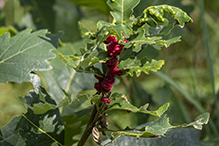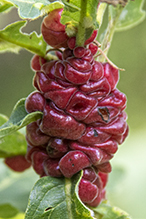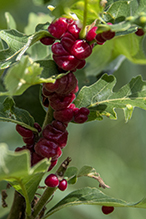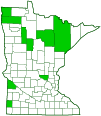oak fig gall wasp
(Trigonaspis quercusforticorne)
Conservation • Description • Habitat • Ecology • Distribution • Taxonomy
|
|
|||||||||||||
Description |
Oak fig gall wasp is very small for a wasp but medium-sized for an oak gall wasp. It occurs in northern United States from Massachusetts to Minnesota, south to northern Indiana, and in southern Ontario and Manitoba Canada. It produces galls on oaks in the white oak group. In Minnesota this includes white oak and bur oak. In other areas it is also found on chestnut oak, swamp chestnut oak, and dwarf chinkapin oak. The life cycle of this wasp involves alternation of generations, one generation with only asexual females, and one generation with both sexual males and sexual females. The adult female wasp of the winged sexual generation is light colored and more than ⅛″ long. It is short-lived and does not eat. The front part of the body (mesosoma) is strongly arched and appears hump-backed. The antennae are stout and have 14 segments. They are thread-like and are not elbowed. The abdomen is oval and shiny. It is longer than the head and thorax combined. The wings are well developed and large. The front wings have reduced venation, fewer than six closed cells. The radial cell (R) is elongated. The second radial vein (R2) is not strongly bent. The second segment (trochanter) on each leg has two segments. Due to their small size, these adult wasps are impossible to identify in the field. However, they are easily identified by the abnormal plant growths (galls) they produce. Galls are formed in summer. They usually appear as numerous galls closely packed together in a compact cluster. They often completely surround a small, actively growing branch or twig. They sometimes appear on a petiole or a leaf midrib on the upper or lower leaf surface. Each gall is thick-walled, soft, and bladder-like, not woody. It somewhat resembles a fig. This is the feature that gives the species its common name. The galls may be yellow, light yellowish-green, tan, dark red, or brown. The outer surface is densely covered with short, fine hairs. The entire cluster can be detached from the twig or leaf. |
Size |
More than ⅛″ long |
Similar Species |
Habitat |
White oak and bur oak |
Ecology |
Season |
Summer and fall |
Behavior |
Adults do not sting. |
Life Cycle |
The life cycle of this wasp involves alternation of generations, one generation with only asexual females and one generation with both sexual males and sexual females. After mating in the fall the sexual female wasp drops to the ground. She burrows into the soil at the base of a host tree and injects her eggs into the tree’s roots. These eggs, the first generation embryo stage, overwinter. When they hatch in the early spring, the larvae begin feeding on the roots. Soon they enter the pupal stage, a period of inactivity and metamorphosis. Later, the wingless asexual female adult hatches and emerges from the soil. She crawls up the tree trunk, finds a young twig, and injects her eggs. These eggs are the second generation embryo stage. The eggs hatch and the larvae begin feeding on the inner bark and soft outer wood. This causes a chemical reaction that results in the formation of a fig-like gall. The galls appear in the summer. Second-generation, winged, male and female sexual adults emerge in the fall and immediately search out a mate, completing the cycle. |
Larva Food |
Inner bark and soft outer wood of young twigs on oaks in the white oak group |
Adult Food |
Adults do not feed. |
Distribution |
||
|
Sources |
|
| 9/2/2024 | ||
Occurrence |
||
|
||
Taxonomy |
|
Order |
Hymenoptera (Ants, Bees, Wasps, and Sawflies) |
Suborder |
Apocrita (narrow-waisted wasps, ants, and bees) |
Infraorder |
Proctotrupomorpha |
Superfamily |
Cynipoidea (gall wasps and allies) |
Family |
Cynipidae (gall wasps) |
Subfamily |
Cynipinae |
Tribe |
Cynipini (oak gall wasps) |
Genus |
Trigonaspis |
Subordinate Taxa |
|
|
|
Synonyms |
|
Trigonaspis quercusforticornis Xanthoteras forticorne Xanthoteras quercusforticorne Xanthoteras quercusforticornis |
|
Common Names |
|
oak fig gall wasp |
|
Glossary
Gall
An abnormal growth on a plant produced in response to an insect larva, mite, bacteria, or fungus.
Mesosoma
In Hymenoptera: the front part of the body, consisting of all three segments of the thorax and the first segment of the abdomen, to which the wings are attached.
Visitor Photos |
||
Share your photo of this insect. |
||
This button not working for you? |
||
|
||
|
||
MinnesotaSeasons.com Photos |
||
 |
 |
|
 |
 |

Slideshows |
|

Visitor Videos |
||
Share your video of this insect. |
||
This button not working for you? |
||
|
Other Videos |
||
|

Visitor Sightings |
||
Report a sighting of this insect. |
||
This button not working for you? |
||
Kathi Sloan |
Location: Popple Township, 15023 366th Street Bagley, MN 56621 |
|
MinnesotaSeasons.com Sightings |
||

Created: 9/21/2021 Last Updated: © MinnesotaSeasons.com. All rights reserved. |
